Follow me:

Date posted: December 29th 2016
Book Title: Washington - A Life (Part 3)
Book-in-a-sentence
If america was a wheel, Washington was the hub at which all the departments of state connected as brilliant spokes and turned as one.
My Summary (audio)
The Cincinnatus
Alright! This final part starts right after the peace treaty was signed in Paris. This happened in 1783 when Washington was 51 years old. Now, some of you may be thinking that he immediately became president, but that’s not what happened. In fact Washington did something that almost nobody could have anticipated: Despite having the entire nation on the palm of his hand, and having won the approval and trust of even his toughest critics, he went home...
Just like Lucius Quinctius Cincinnatus did when he gave Rome back to the people, Washington gave America back to the people. In fact some people called him “the Cincinnatus” because of this amazing feat. He emphasized that he was “no longer a public man” and that he wanted to “spend the remainder of his days in the practice of domestic virtues”. And I’m sure he meant it, but he couldn’t have been more wrong... No longer a public man? Please...He was a freaking celebrity! Everyone wanted to come to Mount Vernon and meet the man who defeated the most powerful Navy in the world. A living legend.
On the other hand he kind of HAD to go back home. His plantation was pretty much bankrupt—I think eight years of neglect would do that to any business. But who could blame him? After all (if you recall from the previous post), he was a little busy fighting the British. Either way, he came back, and started reconstructing his little empire. But it wasn’t easy. Terrible winters hit once again, the American currency was severely devalued, and his land tenants in Ohio hadn’t paid rent for years! He had a lot of work to do. And to make matters worse, he was constantly getting distracted by annoying visitors who would stay for several days. He also had to adopt three kids from dead relatives. It was a mess!
But as you would expect, slowly but surely Washington started making things right again. With his incredible discipline, excellent vision and judgement, he made a ton advances in agricultural matters. Bringing the farm back to life. He also became super obsessed about the navigability of the Potomac—he wouldn’t shut up about it—he saw this river as a highway to the Ohio country and a gateway to westward expansion. As usual, he was thinking beyond what most people saw.
All and all, in less than five years, he went back to being the great magnate he was before the Revolution. And just like before the Revolution, he occasionally took sneak‑peeks at the political world. He just couldn’t help himself, after all he had given birth to baby America and just like any father, he wanted his baby to grow into a healthy child!
Unfortunately after four or five years of being born, it became apparent that baby America was not going to make it unless her upbringing was seriously modified. This “upbringing” was (at that moment) dictated by the Articles of Confederation
-
Which were drafted and ratified during the war. They also have a similar first line to that of the constitution—but not quite as cool… “To all to whom”... As opposed to the amazing “We the people” later drafted for the Constitution↩
-
Yes, a rebellion to the rebellion...↩
-
Although I would argue that most of the ideas actually came from John Adams and Ben Franklin↩
-
Also the third president of the United States↩
-
Also the fourth president of the United States↩
-
If you are wondering why Hamilton was never a president like Jefferson and Madison; well, aside from getting killed later on on a stupid duel, he was not born in the US, and this was (and still is) a requirement.↩
-
More on the French Revolution later↩
-
We met Knox last post, he was one of Washington’s favorite Generals↩
-
The moderator to put it another way, I think the word president is a little confusing (if we consider what will happen next).↩
-
Classic Hamilton rattling the cage↩
-
I’m pretty sure it was not worth a free meal↩
-
The guy who convinced the French to join the Revolution. A brilliant politician and an amazing scientist.↩
-
The second president↩
-
You see, the constitution was not accepted as willingly as you may think. It represented significant changes that not everyone agreed with.↩

First page of the Articles of Confederation
Image under Public Domain via Wikimedia Commons
The MVPs
Now, these three characters are very important from here on. Alexander Hamilton, Thomas Jefferson, and James Madison, so let’s get familiar with them. You all remember Hamilton right? One of my favorites! Young and energetic, he was the soldier who shot a cannonball at the head of a statue of King George II after the Trenton and Princeton victories. He had know Washington for years, fought beside him, and was well aware of his temper—but most importantly knew how to work with him. Out of these three, Hamilton was probably the one who agreed with Washington’s ideas the most.
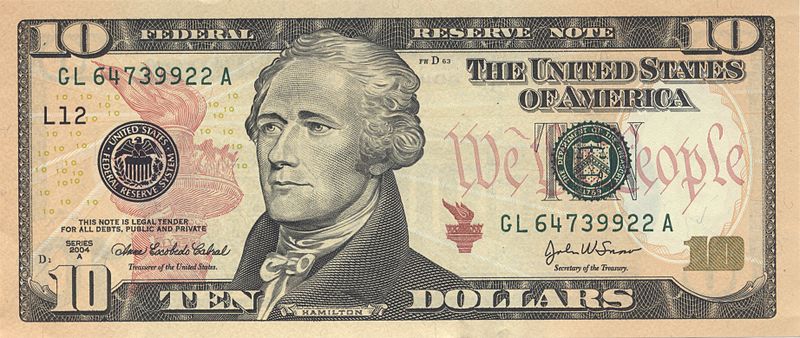
A ten dollar bill showing Alexander Hamilton’s portrait based on an 1805 portrait by John Trumbull.
Image under Public Domain via Wikimedia Commons
Then we have Jefferson. Another plantation owner just like Washington, and about a decade younger. Brilliant guy! Very educated and a very prolific writer. He is said to be the author of the constitution
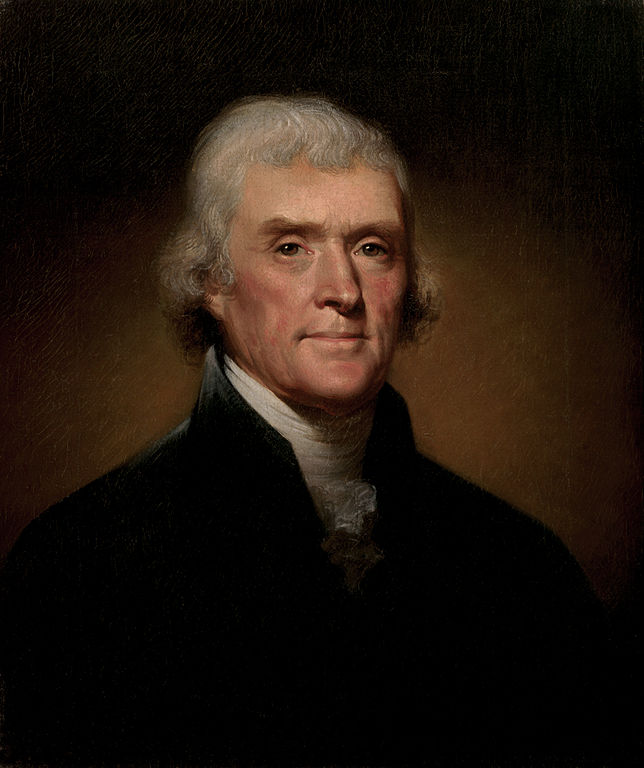
A portrait of Thomas Jefferson by Rembrandt Peale
Image under Public Domain via Wikimedia Commons
And finally we have James Madison. People said he was short and ugly. Some people went as far as calling him repulsive and cold. But his looks didn’t stop him from being extremely influential to the foundation of the United States. He was also a very good writer, and always the best prepared person in the room. Madison would read articles and books like crazy before discussing any subject. Very outspoken (unlike Jefferson) and very persuasive.
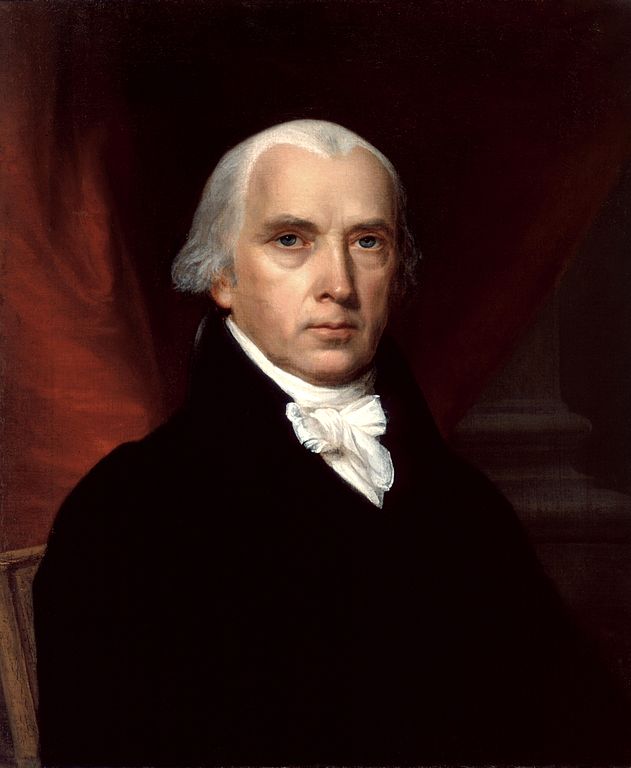
A portrait of James Madison by John Vanderlyn
Image under Public Domain via Wikimedia Commons
These three guys will become Washington’s MVPs during his first term—Hamilton, very energetic, and a little reckless. Jefferson, very smart, but succinct. And Madison, quick on the spot, but very sharp and precise.
The three branches
Ok, now we can come back to the story. We were talking about the Articles of Confederation and how they needed to be revisited, right? Well it was Hamilton who set the date to get together and “review” the articles. He set it around May 1787. This is five years after the recognition independence. Five years in which Washington was trying to put Mount Vernon back together piece by piece, while the country was collapsing over its own weight. Everyone feared a second Revolution—which would pretty much end up in civil war.
Because of this imminent threat to the integrity of the colonies, almost everyone agreed that changes had to be done, but the question is, where? and how? Some people had fears about a centralized government because it could roll everything back into monarchy. Others feared having too much of a congressional power because there wouldn’t be unity and patriotism, besides nothing would ever get done. It was hard... Let’s keep in mind that this is a time where all they knew was monarchy, but they hated it! They had to come up with something new!
To make the task even harder, they they didn’t have any other countries to look up to and say “hmm let’s try what they have” No, they were the first ones facing this problem. And THAT is what makes the American Revolution so much more impressive than any of the revolutions that came after that. All the revolutions that happened after this one were looking at George Washington as their hero, their role model. And looked at the United States as a mold. Even the French Revolution is thought to be modelled after the American Revolution but unfortunately it involved a much more blood‑thirsty crowd
Anyway, they needed to come up with something before chaos broke loose, and that’s why they chose to review the Articles. A couple of months before the meeting, the congressman John Jay sent a letter to Washington with a little sketch of three objects and some scribbles, saying: “Let congress legislate, let others execute, let others judge...” Simple right? Little did he know he was introducing the Three Branches of Government, an idea that would bring stability to half of the world for the next 240 years! Talk about changing the world! This guy…
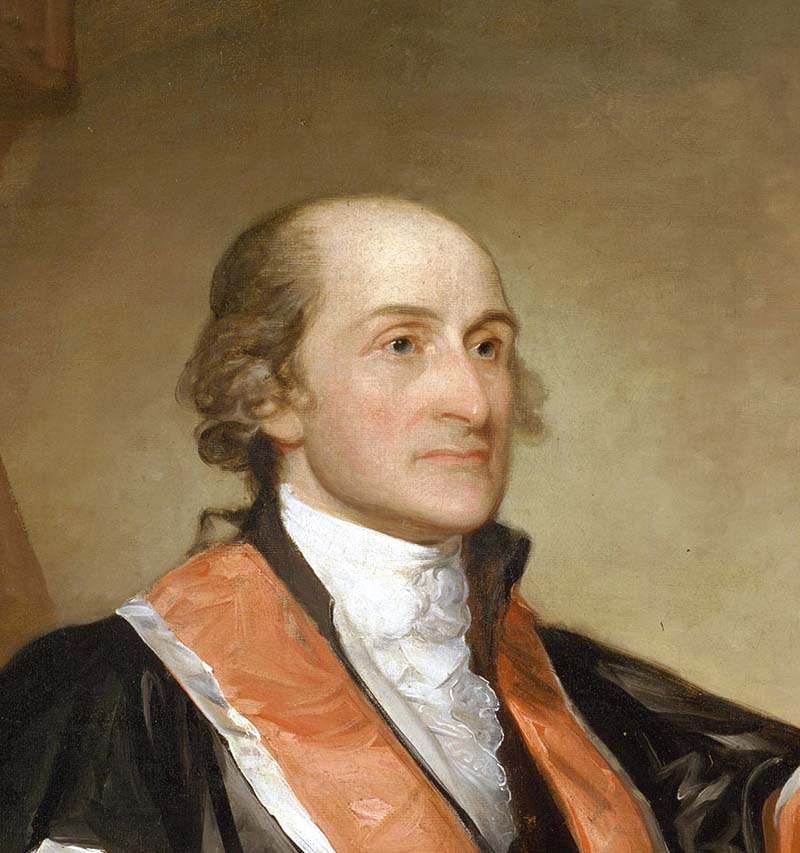
A portrait of John Jay by Gilbert Stuart (cropped)
Image under Public Domain via Wikimedia Commons
That letter from Jay was in fact a letter to persuade Washington into joining the meeting to reform the Articles of Confederation, to be held next May. But Washington declined, he just wanted to be a farmer. Hamilton, Madison, Jay, and a bunch others, kept sending him letters, begging him to join—they knew that without him the meeting would not coalesce.
In the end it was Henry Knox, the artillery chief during the war, who convinced Washington to be a part of this meeting
On that note, Washington agreed, and the meeting kicked off on May 25th 1787.
They forced Washington to sit up in the high chair and act as “the president of the meeting”
But you see what he was doing? He acted as an overlord. Observing in silence making everyone feel the pressure that if they fucked‑up, he would be right there watching them…
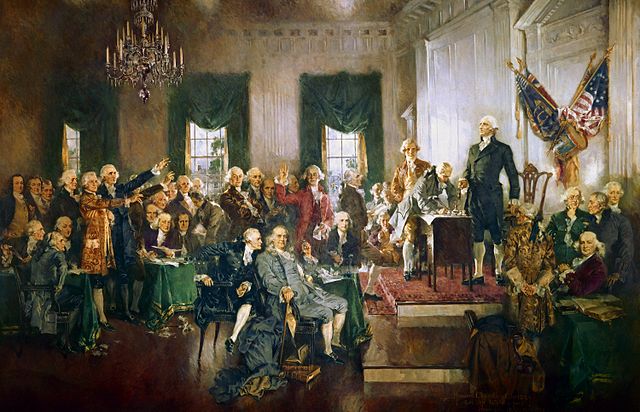
Scene at the Signing of the Constitution of the United States.
Image under Public Domain via Wikimedia Commons
A funny anecdote during these meetings happened when this one dude said “Ohhhh come on! General Washington is not that bad, in fact he is very amiable...” To which Hamilton responded, “oh yeah? I’ll pay everyone’s dinner tonight, if you dare to pat him in the back”
Yes… George Washington, the guy who everyone loved but nobody touched…
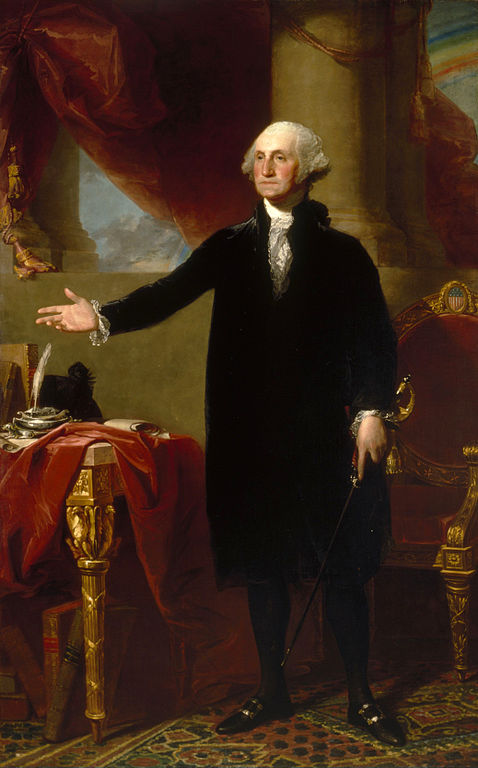
A portrait by Gilbert Stuart. Washington seems to be extending his hand to someone. Which is funny, because George Washington didn’t shake anybody’s hand.
Image under Public Domain via Wikimedia Commons
It took this group of exemplary individuals about four months to transform the Articles of Confederation into a brand new document called “The Constitution”. They built up on Jay’s idea of the three branches, trying to touch all subjects—except slavery, that subject was avoided like a plague. But in the end, they came to an agreement. It was definitely not a perfect document but they thought it would do for the time being.
One of the main sections of the constitution established that there would be a president for this new nation, and Washington came back to Mount Vernon that September almost sure he would end up being the president (as much as it scared him). He kept acting like he didn’t want it, and he probably didn’t, but there was no one else. Franklin
The elections didn’t take place until two years later, because the Constitution had to be ratified (accepted) by all states which took about a year
Washington won unanimously that April, and the news united the country like never before. People knew he was the only man who could save the country a second time.
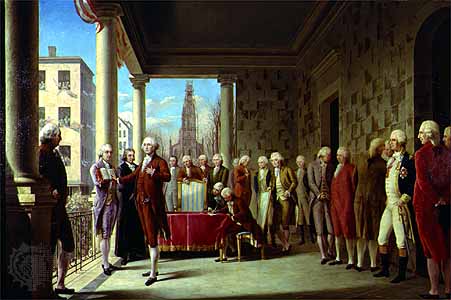
Oil painting of George Washington’s inauguration as the first President of the United States.
It’s funny that this bible he is putting his hands on, was a last‑minute thing. Because in an attempt to make his inauguration seem more majestic, someone thought about using a bible to swear over. A simple act that (even today) makes people have a hard time separating church and state.
Image under Public Domain via Wikimedia Commons
Click on the next button to keep reading
